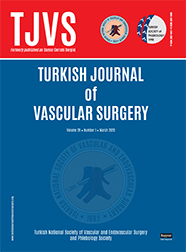
The Turkish Journal of Vascular Surgery
Yazarlar: Bahadır GÜLTEKİN, Hakkı Tankut AKAY, Deniz Sarp BEYAZPINAR, İlknur AKKAYA, Özgür ERSOY, Ahmet HATİPOĞLU
Konular:-
Anahtar Kelimeler:Endovenous laser treatment; radiofrequency ablation; saphenous vein; venous reflux
Özet: Objective: The improvements in minimally invasive procedures for the treatment of varicose veins aim to reduce operative trauma and bruising associated with standard surgical techniques. There are two major thermal endovenous treatments in use; Endovenous Laser Ablation (EVLA) and Radiofrequency Ablation (RFA). The aim of the current study was to compare the efficacy, early postoperative morbidity, patient comfort and effects on venous clinical severity score (VCSS) of EVLA and RFA. Material and Methods: In this study, 134 patients presented with symptomatic unilateral primary venous insufficiency due to great saphenous vein (GSV) incompetence were analyzed. The patients were classified according to the CEAP (clinical, etiologic, anatomic, pathophysiologic) classification. Patients were randomised into two groups. Group 1 (n=82) was treated with the radial laser fiber, and group II (n=52) was treated by endovenous radiofrequency. Patients were called for control visits at the end of the first week, the first month, and sixth month. Routine postoperative duplex scanning was performed in the follow up visits. Limbs were examined for successful obliteration, pain, bruising, erythema, and hematoma at each postoperative visit. CEAP clinical class and VCSS scores were recorded. Results: There was more bruising and painful eryhtema in the RF group at the end of the first week (p=0.001), painful erythema was reported in 7 patients in RF and 1 patient in EVLA group, and 5 bruise in RF and 2 bruises in EVLA group. However, there was no difference in bruising and erythema among the groups at the end of the first month. There was no statistically significant difference among the groups for complications such as skin necrosis, edema and minor paraesthesia. Returning to daily activities and the workplace was similar in two groups. Conclusion: We may conclude that RFA and EVLA both effectively reduce superficial venous insufficiency from incompetent GSVs. EVLA was associated with less bruising in the periprocedural period.